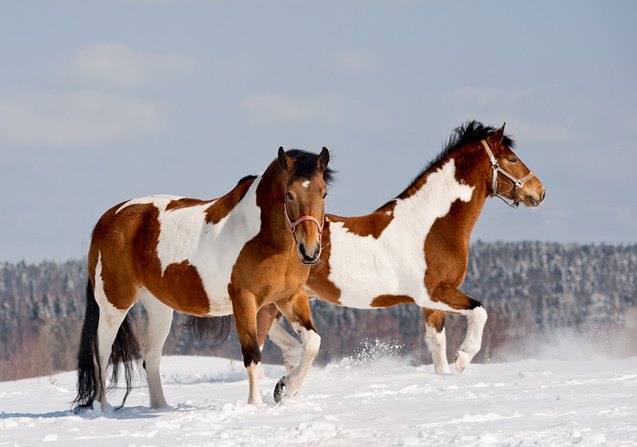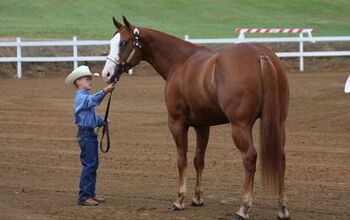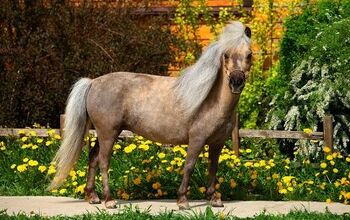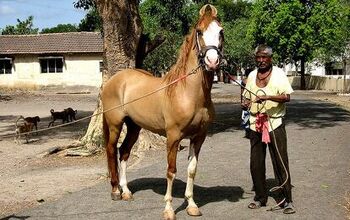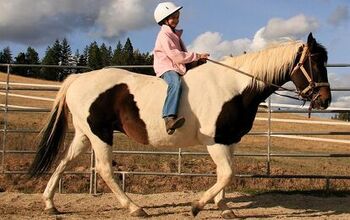Pinto Horse


About Pinto Horse
The Pinto Horse breed is the result of wild horse herds breeding with European horses. The horses were brought to America by settlers, and they were eventually domesticated by the Native Americans, who preferred these horses because their color pattern acted as camouflage in the environment.
Pinto can actually refer to any equine breed that exhibits tobiano, overo, and tovero color patterns. However, the most common breeds that exhibit these particular color patterns include the Icelandic Horse, the Mustang, the Arabian, and the Saddlebred Horse.
The Pinto Horse is bred for its color pattern.
Even though spotted horses appear to have originated with the horses of American Indians, the two-toned pattern that is so distinctive on the coat of a Pinto Horse likely arrived in North America via the Spanish and Arabian stock that came with the early explorers. Native Americans preferred the horses’ spotted color and ended up breeding the horses for this particular characteristic. Later, Western settlers bred their horses with Indian ponies, and this allowed for the unique color pattern to continue.
Even though the Paint and Pinto breeds are lumped together a lot, they are not the same breed. This is because the American Paint Horse has to have original stock blood from a Thoroughbred or an American Quarter Horse. The Pinto Horse, on the other hand, is considered a color breed. Therefore, these horses can have any parents of any breeds, as long as the coat requirements for the Pinto are fulfilled.
Even though the Pinto color can happen in any horse breed, the Pinto Horse Association of America will not accept any horses with Draft, mule, or Appaloosa characteristics or breeding.
The Pinto Horse is bred for its color pattern. As a result, many different equine breeds can exhibit the Pinto appearance. When it comes to breed traits, therefore, it is difficult to narrow down the exact personality of a Pinto Horse, as that will ultimately depend upon the breed of a Pinto Horse.
Generally, however, the breeds that exhibit the Pinto pattern are intelligent, trainable, and easygoing, as well as versatile, strong, and athletic. There is a Pinto Horse for every type of rider and for horse owners of all experience levels. Also, the Pinto Horse is multi-talented and can be used in a variety of settings and for a variety of tasks.
There is a Pinto Horse for every type of rider and for horse owners of all experience levels.
Because the Pinto is bred for its coloring, there is also no set conformation that will make a horse a Pinto. In other words, any equine breed, from a Thoroughbred to a Miniature Horse, could be a Pinto as long as it has the right colors and patterns. But even though the Pinto Horse does not have a consistent conformation because it is bred for its color, there are four types of conformation that are acknowledged.
The Pinto conformations that are acknowledged are the Stock type, the Hunter type, the Pleasure type, and the Saddle type.
The Stock type has a Quarter Horse conformation, while the Hunter is predominantly Racing Quarter Horse, warmblood, or Thoroughbred conformation. The Pleasure will have a Morgan or Arabian conformation, while the Saddle will have a Tennessee Walking Horse, Hackney, or Saddlebred conformation.
Tobiano and overo are the two most common colors for Pinto Horses.
A horse with a white body and large areas of color all over the whole body will be categorized as tobiano. On the other hand, a horse that has a base color and exhibits uneven markings of white on the sides of the body is considered overo.
Also, if the darker color on the Pinto Horse is black, it is described as a Piebald, but if the darker color on the horse is any color other than black, it will be described as a Skewbald.
A tovero color pattern can occur from breeding an overo with a tobiano horse. In the majority of cases, doing so will create a coat pattern that is actually a mix of both the tobiano and the overo patterns.
The Pinto Horse is multi-talented and can be used in a variety of settings and for a variety of tasks.
The Pinto Horse requires regular grooming in order to maintain its beautiful appearance and keep its coat healthy. You can purchase a set of horse grooming tools that includes a body finishing brush, a curry comb, a dandy brush, a mane comb, a shedding blade, a tail brush, and a hoof pick.
Use the body finishing brush for the face and legs, the curry comb to remove dirt and loose hair, the dandy brush to remove even more mud, dirt, and loose hair, and the mane comb to smooth out the mane. The tail brush can be used on the tail, the shedding blade can be used to loosen hair from the horse’s coat, and the hoof pick can easily remove debris and rocks from the animal’s hooves.
Photo credit: accept/Bigstock; holbox/Bigstock; mari_art /Bigstock

Lisa Selvaggio is a freelance writer and editor, and our resident cats-pert, with certifications in pet nutrition and pet first aid. She enjoys producing content that helps people understand animals better so they can give their pets a safe and happy home.
More by Lisa Selvaggio





